How To Create Bio Data For Job
Landing an interview is a race against the clock—dozens of job seekers have already written their resumes and applied for *your* dream job.
How to beat them and land that position?
Let's get started with our step-by-step guide on how to make a perfect resume.
Want to save time and have your resume ready in 5 minutes? Try our resume builder. It's fast and easy to use. Plus, you'll get ready-made content to add with one click. .
Create your resume now
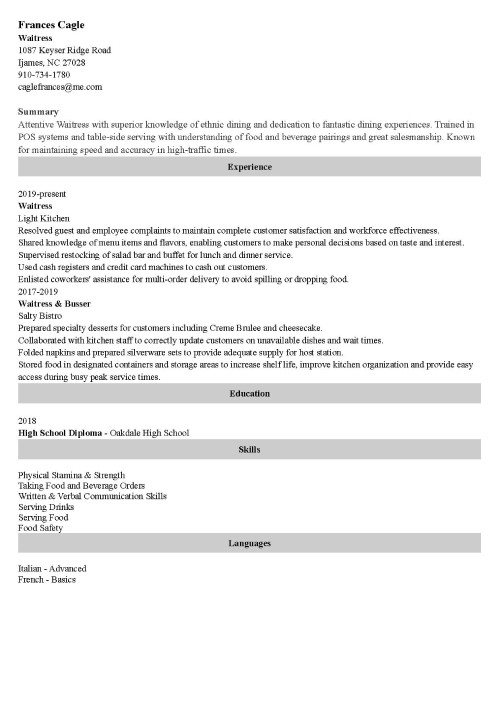
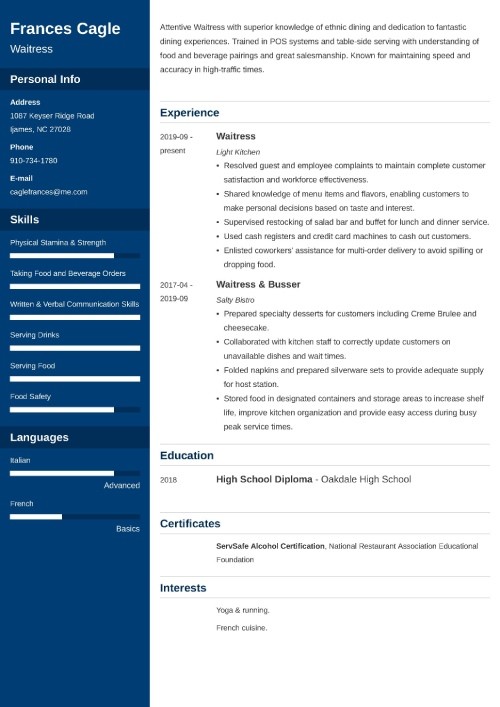
Sample resume made with our builder—See more templates and create your resume here.
For maximum efficiency, make an resume for your specific situation:
- Resume With No Experience
- Entry-Level Resume
- Student Resume
- College Student Resume
- Internship Resume
- College Application Resume
- Teen Resume
- Resume for a Part Time Job
- Resume With Employment Gaps
- Career Change Resume
- Military to Civilian Resume
- Federal Resume
- US Resume
- Canadian Resume
- Specific Resume Examples for 500+ Jobs
Or, if you don't find the example you need in the list above, keep your chin up as you scroll on down.
This is how to write a resume step by step:
- Choose the Right Resume Format
- Add Your Contact Information and Personal Details
- Start with a Heading Statement (Resume Summary or Resume Objective)
- List Your Relevant Work Experience & Key Achievements
- List Your Education Correctly
- Put Relevant Skills that Fit the Job Ad
- Include Additional Important Resume Sections
- Complement Your Resume With a Cover Letter
- Proofread, Save & Email Your Resume the Right Way
What the US and Canada call a resume, most of the rest of the world call a curriculum vitae (CV). South Africa, India, New Zealand, and Australia tend to use the terms resume and CV interchangeably. For more, you can learn the differences between a resume and a CV.
If you're an international reader, switch over to:
- How to Write a CV for a Job in 7 Easy Steps: (15+ Examples)
- Biodata Format for a Job in India
And here's a guide on how to create a professional resume:
1
Choose the Right Resume Format
You can't just start writing a resume by putting your info together in the resume template all willy-nilly.
Instead, first select from the standard resume formats:
Reverse-chronological format
Pros: Traditional resume style, familiar to potential employers.
Cons: Very common, not the most creative resume design format.
Combination format
Pros: Great for experienced pros and career changers for highlighting transferable skills.
Cons: Uncommon type, not as familiar, not recommended for entry-level job seekers.
Functional format (skills-based)
Pros: Entry-level job hunters can emphasize skills over lack of experience.
Cons: HR managers may think you're hiding something.
Most job applicants will likely want to choose the reverse-chronological resume template:
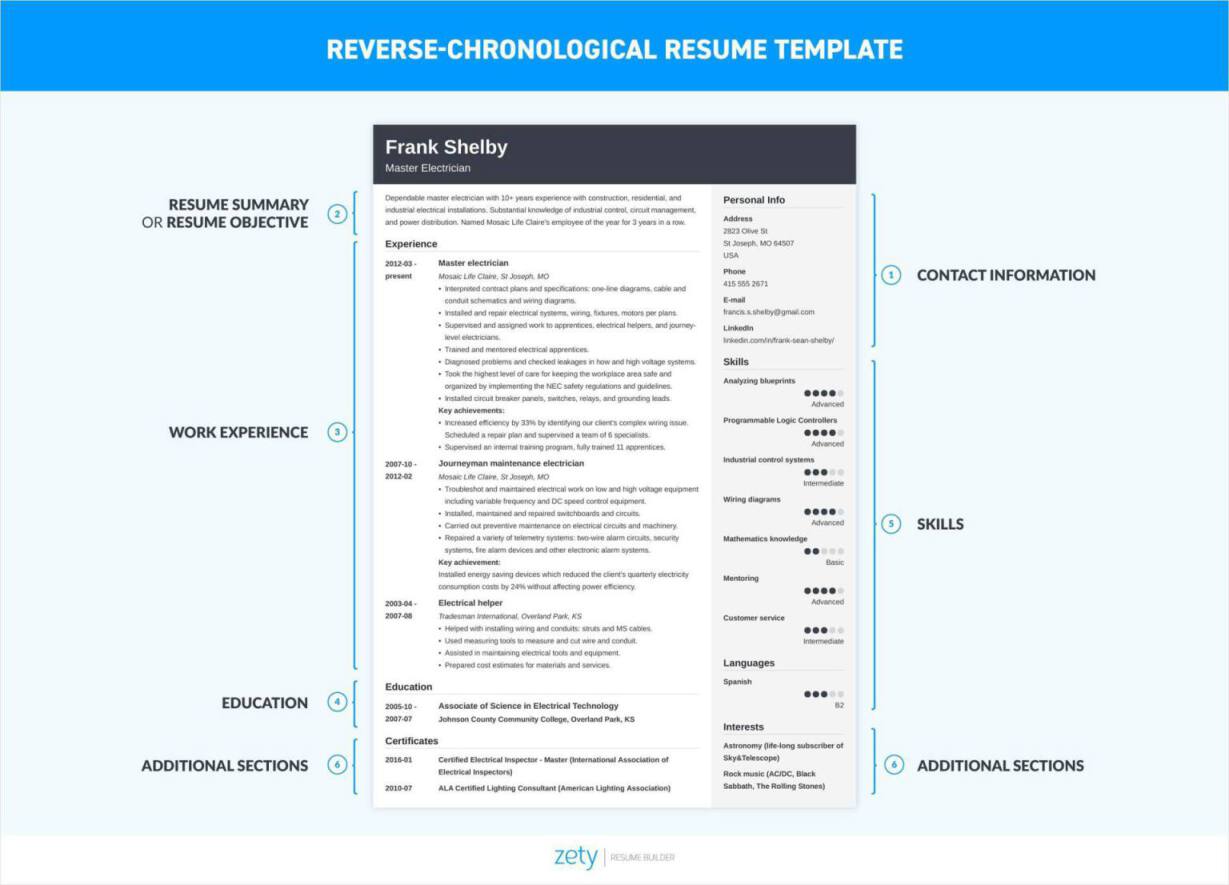
The chronological resume is a traditional resume format which emphasizes your duties, experience, and work history. You'll list your most recent positions first, and go back through past jobs in reverse-chronological order from there. As the standard, basic resume format, it tends to be the easiest to read and scan.
As for the question of how to spell resume? It's still a bone of contention, but we thinkresume without the accents is the best choice.
To learn more about the best resume format to use for your particular situation, compare the common resume format examples, or check out our articles on the chronological, combination, or functional formats and resume design. And also take a look at our guide to free resume templates.
Resume Tip: There are several studies that theorize relationships between resume cues and the applicant's personality and hireability, further impacting hiring judgments through resumes. Be careful which info you choose to include!
2
A career diplomat knows what information should be given and which to hold back.
Likewise, on a great resume contact information section, there are basic items which you must include, personal details that are recommended, and some data which you should definitely leave out:
Necessary Contact Information
- Name: First name, last name (middle name optional).
- Phone Number: Personal cell phone preferred over home phone number.
- Email Address: Today's preferred means of communication.
- LinkedIn URL: Include your LinkedIn profile (hiring managers will spy on you anyway).
Optional:
- Leave your address off your resume (unless required)
- Resume title
- Personal website
Personal websites and social media are now a normal thing to list on a resume header:
Starting a blog has genuinely helped me land every job I've ever gotten because my employers have wanted me to help them do the same thing I've been able to do with my own blog.

Ryan Robinson
writer & part-time entrepreneur
Marketing specific advice? Perhaps. But employers will look you up online. Your professional blog will easily show up first in Google and make quite the statement.
Contact Information to Avoid
Date of Birth: Adding your birthdate could lead to ageism. Add only if required, such as for jobs serving alcohol, for example.
Second Email or Phone Number: A second email address, mailing address, or phone number will just confuse them (and you).
Photo/Headshot: In the United States, resume images and profile photos are usually not recommended.
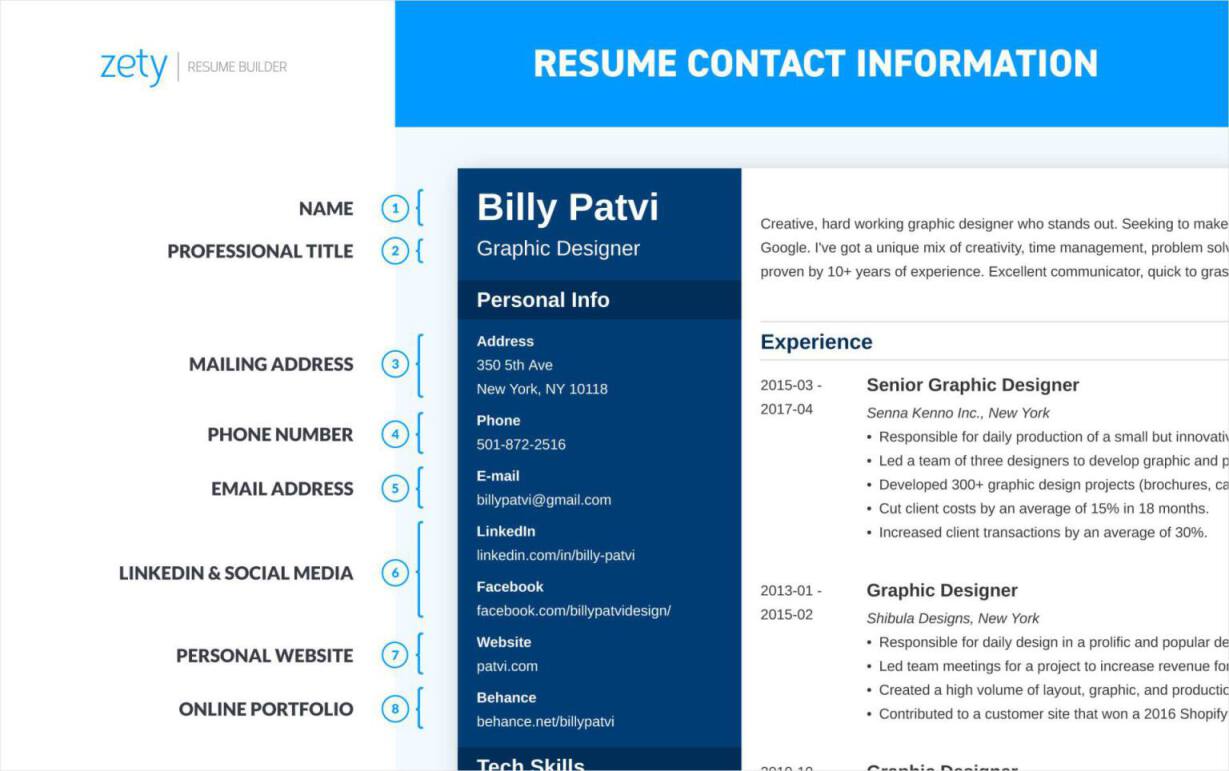
Resume Tip: Give them a professional email address, not your old high school handle (sexypapa69xoxo@....) or an outdated email provider (....@hotmail.com). Studies have proven that a formal email address is much more hireable than an informal one.
To be sure you get the personal details on your resume right, have a glance at our resume contact information guide.
3
Start with a Heading Statement (Resume Summary or Resume Objective)
Most Tinder users have little patience. It takes a witty statement or provocative image to get a match not to swipe left on you.
Well, the employer flips through resumes just like a Tinder user with an attention deficit. In less than 7 seconds, as our HR statistics report shows, hiring managers scan your resume and make an initial decision.
That's why a professional resume heading statement is super-important to get right. You've got to compose a statement, with wit, that paints an attractive image of your candidacy. After all, what is the purpose of a resume but to give the best impression of your clout as a candidate.

Your resume summary statement or resume objective statement are likely to have the most eye time since it's at the top of the page.
Here's how to write a resume profile that makes the recruiter swipe right:
Resume Summary Statement
Got enough relevant experience? Choose the resume summary statement.
A good resume summary works when you apply at a job in which you have experience. It summarizes your position-related skills and qualifications.
Let's take a look at how to write a professional summary, both right and wrong:
| right |
|---|
| Personable and dependable graphic designer with 4+ years expertise in a fast-paced global marketing firm. Achieved company-best quality satisfaction rating according to internal review (99.76%). Seeking to advance career by growing with the DeZine team. |
| wrong |
|---|
| I have been a graphic designer for the last 4 years. In addition to my knowledge of various software and design programs, I also handle some tough customer accounts, and I am always able to work well under pressure, even the tightest of deadlines. |
See the differences here? While the Wrong one has some experience listed, it focuses on everyday duties, not accomplishments. In the Right example, you give evidence of your IT consultant resume skills, achievements, and experience.
Resume Tip: The "right" resume summary above also mentioned the company by name. This is a great way to make sure that your resume feels personalized, rather than just sent to every company out there.
See more resume summary examples.
Resume Objective Statement
Choose the resume objective statement if you have no work experience at all, or at least none related to the position you're applying for (entry-level applicants, career changers, students, etc.).
Since you don't have relevant experience to summarize, you'll highlight transferable skills from other areas. You'll make the case that though you don't have experience with this position, you do have experience relevant to it.
Let's looks at another set of good/bad examples on writing an objective for a resume:
| right |
|---|
| Diligent customer support specialist with 3+ years experience at large computer hardware company. Obtained highest grades in build spec knowledge (100%) and quality (97.3%). Seeking to further career by growing with the BQNY team as an entry-level IT technician. |
| wrong |
|---|
| I am a customer support specialist eager to become an field technician. I don't have experience in field work, but past coworkers have said that I am a quick learner. I am highly motivated because I enjoy being outside for work rather than behind a desk at a cubicle. |
See the differences here? The company is taking a greater chance by hiring someone without exact experience.
So you'll need to show them you have what it takes.
In the Right one, we used some transferable skills from the previous company and some proud resume achievements…with numbers.
Remember: numbers speak louder than words!
The Wrong one doesn't show enough to hold the hiring manager's attention.
Resume Tip: If you noticed, both "wrong" examples above used the first-person. Avoid this on your resume.
See more resume objective examples. And for experienced candidates it's worth considering a summary of qualifications too.
When making a resume in our builder, drag & drop bullet points, skills, and auto-fill the boring stuff. Spell check? Check. Start building aprofessional resume template here for free.

When you're done, Zety's resume builder will score your resume and tell you exactly how to make it better.
4
List Your Relevant Work Experience & Key Achievements
If you think of your resume as a fancy meal, the resume experience section is the main course. It includes the most important things to put on a resume.
You've knocked out the appetizer with the previous sections, so now it's time to fill in your work history and past achievements before moving on.
Let's go through the various job history components of the perfect resume experience section now.
How to format the resume work experience section
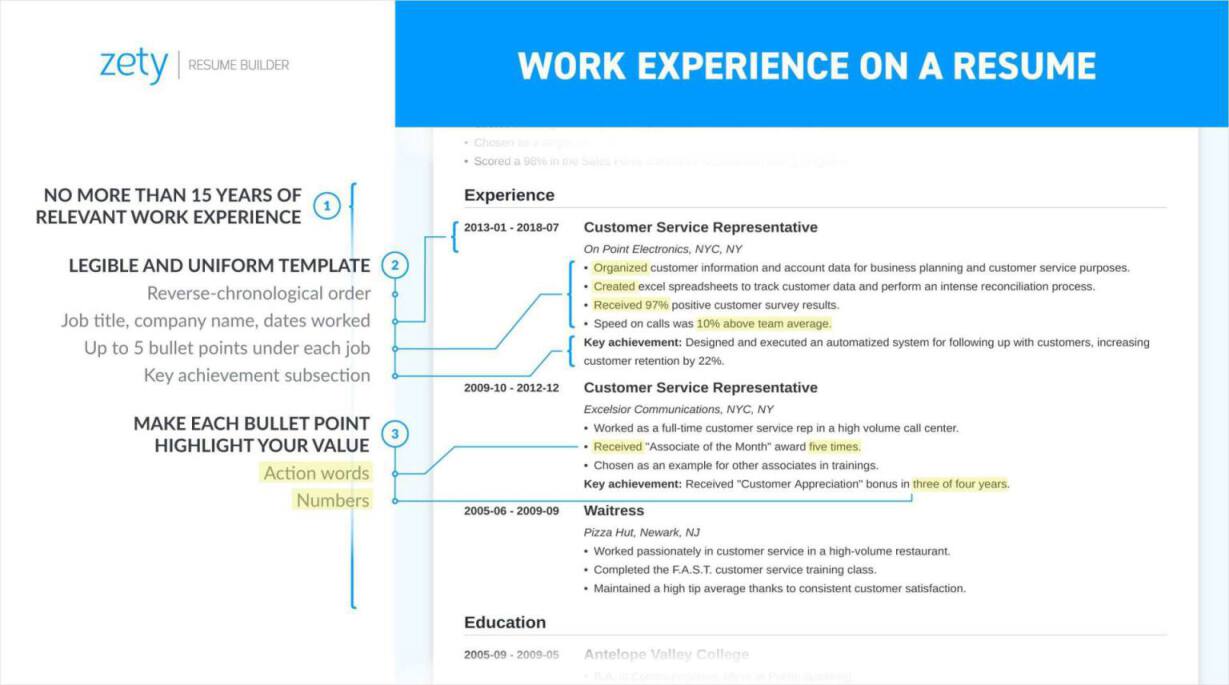
If you look at the above infographic, you'll see our recommended way to format your employment history in the job experience section:
- Job Title—This should go at the very top of each entry of work history so that it's easy for potential employers to scan and find. Make it bold and/or increase the font size by 1pt or 2pts from the rest of the entry.
- Company, City, State—On the second line, include the previous employer's company name, and the city and state of the location you worked at.
- Dates Employed—Thirdly, put the timeframe of your employment there. You can add the year or both the month and the year, but there's no need to put exact days.
- Key Responsibilities—Don't just list every single task you did in your job history. Focus on the few duties most relevant to the new job.
- Key Achievements—Often overlooked, but super important. Employers know what you did, but they need to know how well you did them.
- Keywords—It is important to sprinkle resume keywords throughout the experience section (we'll talk more about this shortly).
If adding more than one job history entry to your resume or CV experience section, start with the most recent position and go back in reverse-chronological order from there.
Use five or six bullet points to make your case in each entry's responsibilities and achievements.
Also, your experience section resume bullet points should go near the top, just under your heading statement. However, if you have little or no professional experience, put your education section above your work history.
Got a promotion you want to show off, or more than one job title within the same company? Don't worry, our guide on how to show promotions & multiple positions will show you how.
Think about accomplishments you've had, not necessarily meaning solid sales numbers or percentages. Were you involved in something that had great success? If so, include it! Showing what you've done beyond your daily duties is what will prompt employers to call you. Employers want to hire someone who exhibits motivation, participation, and ambition.

Erin Kennedy
CEO, Managing Director at Professional Resume Service, Inc.
The work experience section of your resume where you describe your past jobs is the most crucial component of your whole job application. Make sure you get it right: Work Experience on a Resume: Job Description Bullets that *Kill* [100+]
Tailoring your resume work experience
Robots are taking over.
As hiring practices continue to modernize, larger companies are turning to applicant tracking systems (ATS) to give them a hand. ATS software automates the early stages of the recruitment process. How? They look for keywords and assign a score per candidate.
So, tailoring your resume is an absolute must, and your experience section is where you'll do most of it.
To tailor your resume, go back to the job description and look for resume keywords related to your responsibilities.
If you see duties you've performed, include them in your resume job description bullet points.
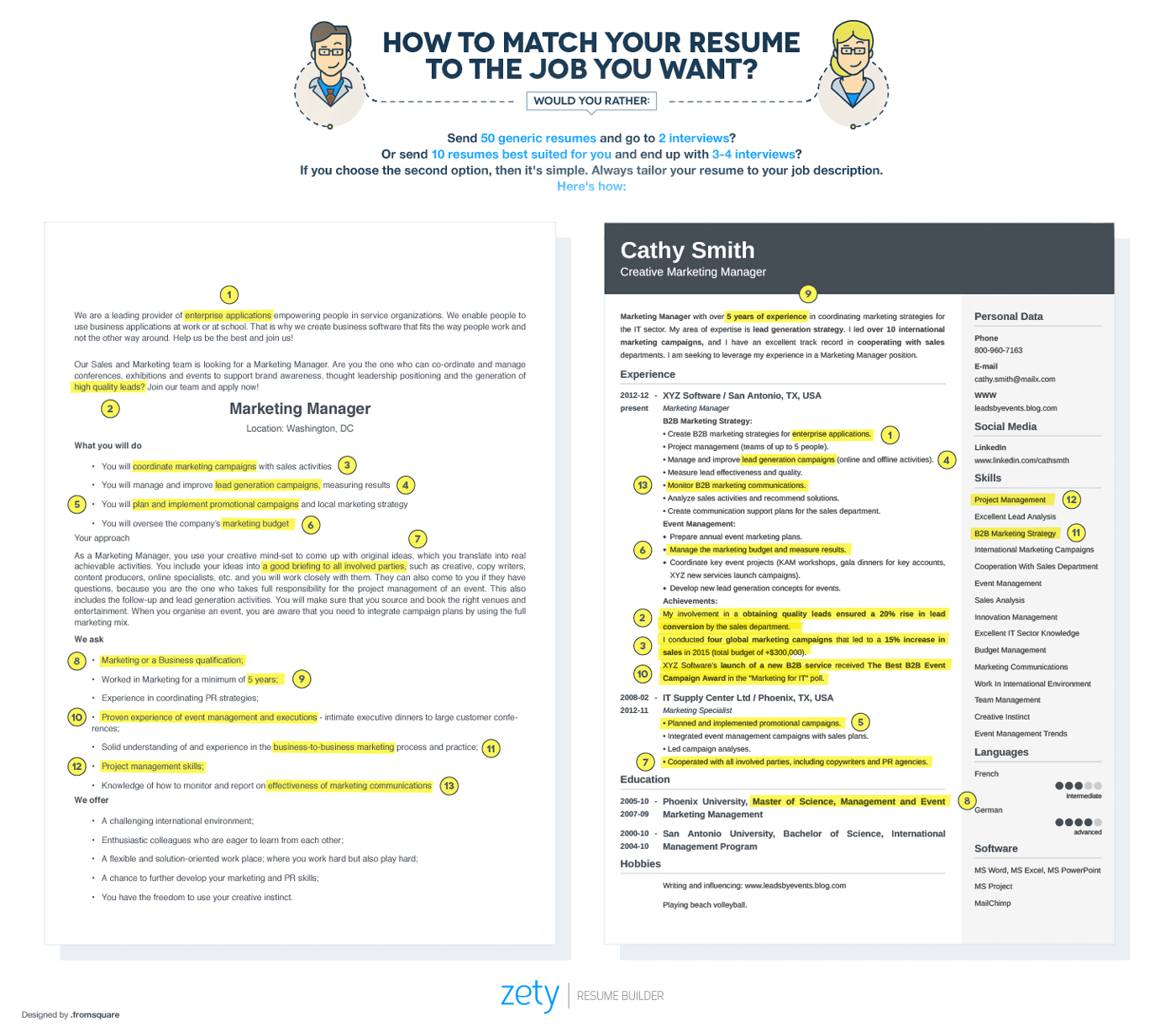
Experienced a spell of unemployment? Don't worry! Check out our guide on how to explain gaps in your resume.
Tailoring your resume also involves knowing how long a resume should be. There are pros and cons for a one-page resume and the two-page resume, but avoid anything longer.
Also, don't use the same, tired words ("responsible for…") in your resume job experience area. Instead, choose power words and action verbs which will keep them interested. Use present tense to describe your current job and past tense to talk about previous experience.
Finally, don't use passive voice, as it feels evasive and unclear. Instead, choose active voice when writing a resume, as it's concise and to the point:
| wrong |
|---|
| Growth team was managed by me. |
| right |
|---|
| Managed growth team. |
How much work experience to include on a resume?
In principle, a resume should go back no more than 10-15 years. But the more experience you have, the less you should worry about the length of your resume. Don't go trying to cram everything into a 1 page resume if you're a highly-experienced candidate.
Senior-level applicants, such as executives and managers, should list up to 15 years of relevant work experience with powerful action verbs to introduce each bullet point.
Mid-level job seekers should include detailed job descriptions of relevant positions and a brief mention of any other positions.
Entry-level candidates should list and describe all paid work, particularly calling out responsibilities and achievements that are most relevant.
First-time job hunters with no work experience can still include other history, such as a student organization role, internship, or volunteer experience, to fill out their experience section.
As you learn how to write a resume, remember the best resume templates will highlight your experience and eligibility. Don't hide it with the wrong order, a dull resume layout, or a template free of character. With dozens of good resume examples, templates, and styles, Zety is the best resume builder online.
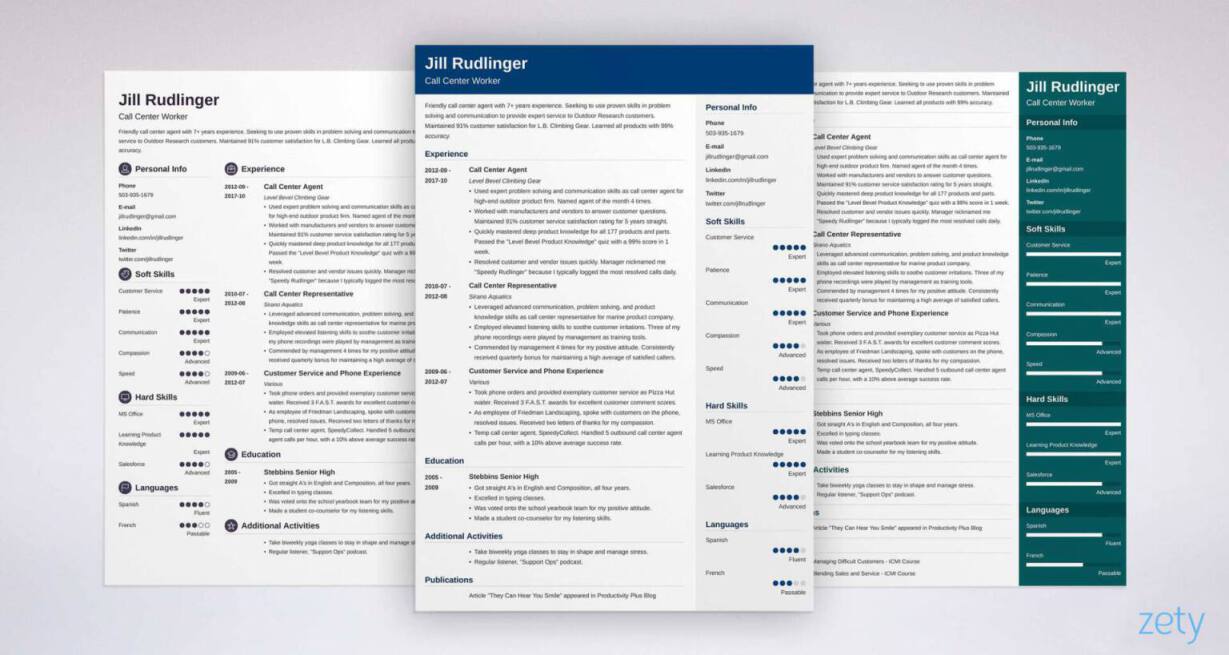
Make a resume in no time with our resume builder app and 20+ great templates.
5
List Your Education Correctly
Many people treat the education section as an afterthought, but you shouldn't. It's an essential part of your resume structure.
Here's how to put education on your resume so you don't get schooled:
- The right resume education order is to place your highest degree first.
- Add any other degrees after in reverse-chronological order.
- If you finished a university degree, don't add high school info.
- Some college on a resume is also fine, just list completed credits.
- Add any relevant coursework, honors, or awards (e.g., making Dean's List) you received.
- Extracurricular activities are a nice finishing touch.
Simple, huh?
Resume Tip: We mentioned this earlier, but we'll repeat it, just in case: if you have little or no working experience, place your education on top and your experience section below it. Otherwise, keep your resume education section just beneath your work history.
Here's a brief look at how to list education on a resume:

We recommend skipping your GPA on your resume. If it's not perfect, it will only count against you.
Want to know how to create a resume education section if you have a GED or didn't graduate? Not sure on the proper resume education format? Check out our article on how to put education on a resume.
Resume Tip: Don't lie in your resume or CV education section. A credit short of a diploma is not a diploma. Also, don't round your GPA up. Anyway, many business degrees don't necessarily improve job prospects.
6
Put Relevant Skills that Fit the Job Ad
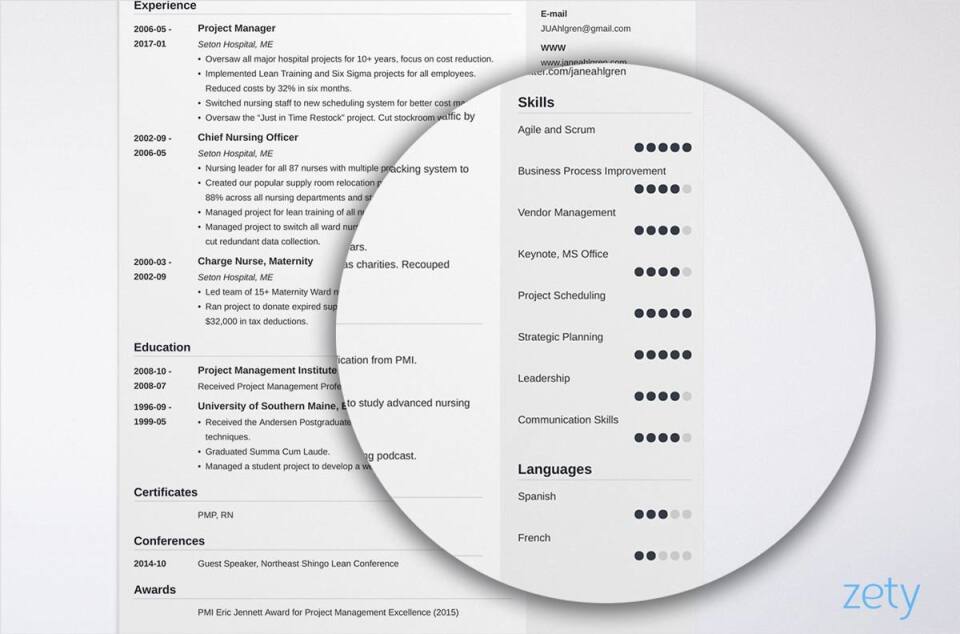
Picture a hunk of beef (the cow variety, not Chris Hemsworth).
Now imagine a well-cooked, perfectly-seasoned steak.
Your resume is one of these two: it's either unprepared to be served, or it's a good resume, the prime cut sprinkled with the perfect resume skills.
Hard skills vs. soft skills
Hard skills are specific abilities and know-how (e.g., Photoshop, cash register).
Soft skills are self-developed, life-learned attributes (e.g., social skills, adaptability).
Combined, these make up a skill set, which is a job seeker's range of skills and abilities.
Resume Tip: Don't list irrelevant skills! An IT resume doesn't need to disclose your veterinary skills, and a resume for a chef shouldn't include your ability to use Photoshop.
What skills to put on a resume?
When you consider how to create a resume that will definitely stand out, it has everything to do with sprinkling your skills throughout. But it also makes sense to have a big section labeled "SKILLS."
Remember that job description you had handy from earlier?
Use the key job-related skills and keywords listed in that ad to help you create a great resume for a job that will make the ATS light up like Times Square.
Here is a list of some common skills to put on a resume:
- Communication skills—These can include social skills, non-verbal communication, listening skills, and interpersonal skills.
- Technical skills—Knowledge required to perform specific tasks, like computer skills or clerical skills.
- Job-specific skills—Particular prowess the company specifically requires.
- Leadership and management skills—Ability to be a good manager, leader, and supervisor.
- Critical thinking skills—Ability to make your own, thought-based decisions and take initiative. Includes analytical skills, decision-making, and problem-solving.
- Organizational skills—A knack for planning, organizing, and seeing initiatives through.
- Transferable skills—for career changers, these are abilities you learned that can be carried over to your new position.
Resume Tip: Don't just google "skills for a [industry] resume" and throw in the results. Take time to tailor your resume skills list to the job posting, as we mentioned earlier.
How to list skills on a resume?
There are several ways to include a list of skills on a resume. For most, a simple skills section which includes 5-6 key abilities and your proficiency level is enough:

For specific job titles and technical skills, you may want to list your particular knowledge per item, to give them specific detail into the areas of the skill you excel at:

Resume Tip: Not every skill is worth mentioning on a resume! Saying you can use Microsoft Word is like bragging about being able to use a fork.
A good resume skills section takes up little real estate but has great impact. For more on how to make a skills resume section, learn what key skills to put on a resume.
7
Include Additional Important Resume Sections
Here's the thing—everyone's resumes include those sections above. But what should a resume include to make it personalized?
Make your resume unique by including extra resume sections.
Additional sections on your CV/resume can showcase just about anything about you, from your proud commendations to languages in which you're fluent and more.
Here's how to make your resume stand out with extra sections:
Hobbies and interests
You might not think that your love of baseball and being the Little League assistant coach would be of interest to a potential employer.
However, listing your hobbies and interests subtly proves your ability to work well in a team, and the coaching can verify your leadership and management expertise.
Volunteer work
Volunteering boosts employability, studies find. For most job seekers, listing any volunteer experience as one of your additional CV sections is a great way to show your commitment and values. It also lets them know that you don't only care about the money. For entry-level or first-time applicants who have no experience, volunteer work makes an excellent stand-in.
Internship experience
Listing internships on your resume is only OK if you're fresh out of school, had one or two other jobs, or you haven't been on the market for longer than 4-5 years.
Certifications and awards
Got any certifications, licenses, or proud awards to show off? If they are relevant to the job and industry, include them!
Placed first in a chili cook-off at the state fair? If you're looking to be a cook, it will definitely help. Likewise, a food safety certification or food handler's license that you already have would surely be in your favor.
Languages
Speak another language? Impressive!
Listing language skills on a resume only extends your usefulness as an employee, particularly in international corporations or localities where there is a large population speaking that second language. List the language, international variation (Latin American Spanish, for example), and your language fluency levels.
Projects
You can include projects as a separate section if you've done a bunch or simply mention one or two below each job description.
Publications
Have articles written for a blog, newspaper, or scientific journal? Mention those publications on a resume. If your published material isn't online, create a short bibliography of the works you'd like them to acknowledge.
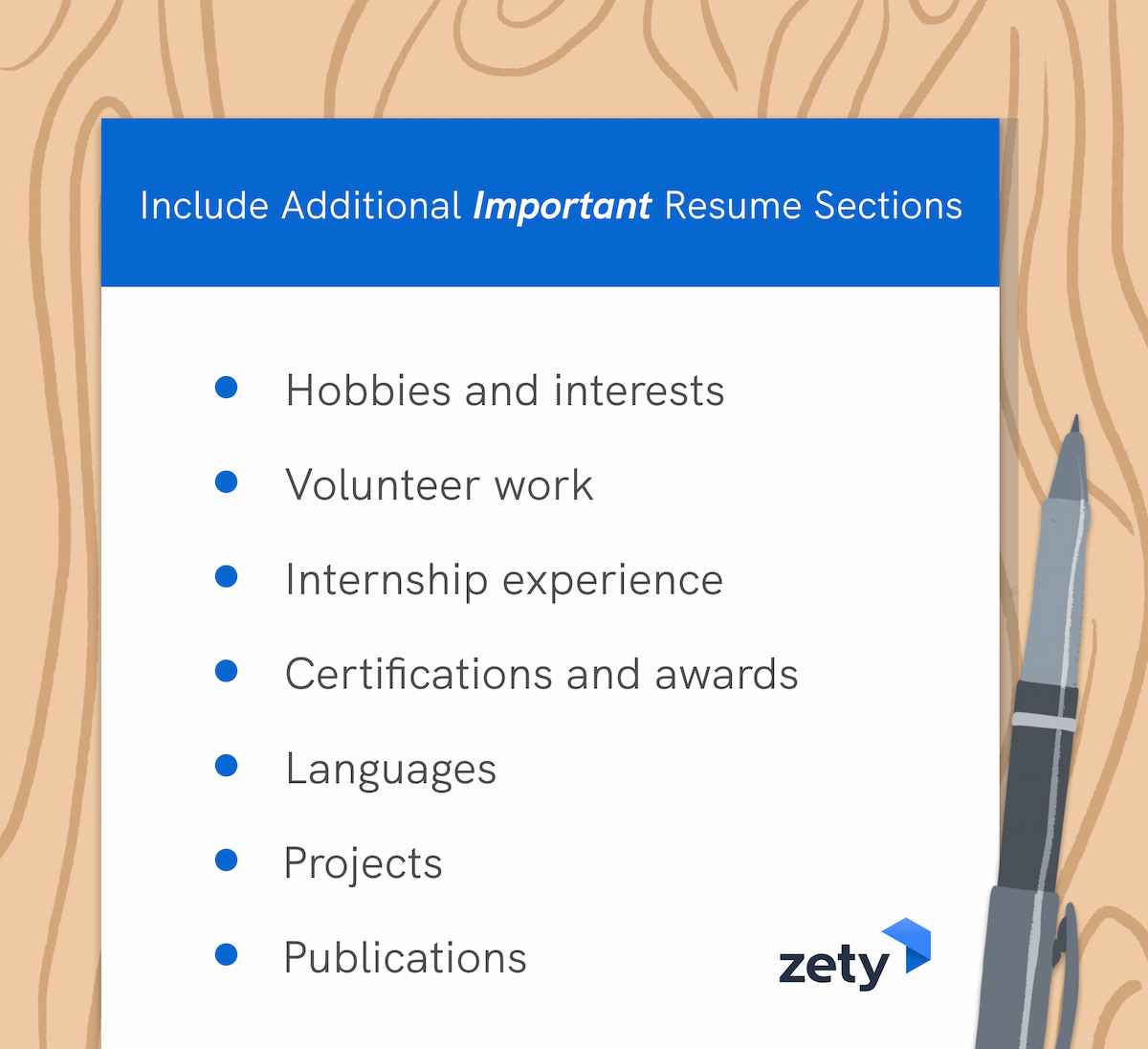
Also, if you've built graphic designs or other creative creations, or if your list of publications or projects is too long to go on a resume, consider building an online portfolio to document everything. Link to it from the contact section, in this case.
8
Complement Your Resume With a Cover Letter
You need to submit a cover letter, most definitely.
Your cover letter or job application letter lets you expand upon things that you need to keep brief on your resume. Also, it allows you to speak easily in normal sentences!
Sound like overkill?
Think again.
Most employers think a resume is not enough to make a decision.
Follow our guide on how to make a cover letter (or a cover letter with no experience or cover letter for an internship), and you'll knock this out quickly and painlessly.
Plus, a great cover letter that matches your resume will give you an advantage over other candidates. You can write it in our cover letter builder here. Here's what it may look like:
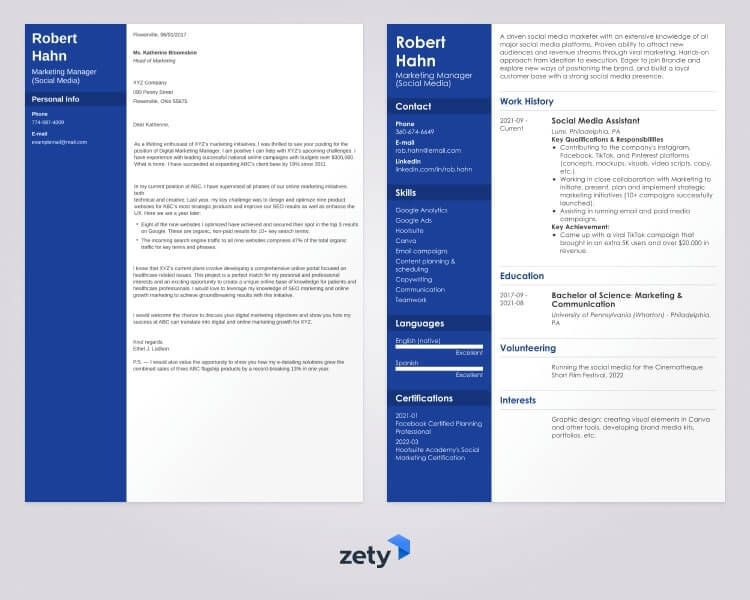
See more cover letter templates and start writing.
9
Proofread, Save, and Email Your Resume the Right Way
You're almost there, but don't send it off just yet.
Here are some resume best practices to keep in mind so you can rest assured that you wrote the perfect resume.
Proofread & double-check
Double-check your CV or resume draft before sending it out. Scan your resume and cover letter (and email!) with a tool like Grammarly. Then, ask a friend or family member to triple-check.
Better safe than sorry!
Resume Tip: Have a look at our guides on resume tips and resume mistakes to avoid, for more.
It can be especially hard to proofread your own resume because you've probably been staring at it for ages. The more time you spend rewriting things and fidgeting with bullet points, the more likely you are to miss that typo in your job title. Even if your experience is impressive, it will look like your attention to detail is lacking, so it's worth running your resume by a fresh pair of eyes.

Brittney Ross
Head Proofreader at Grammarly
Online presence
Remember when we discussed social media and LinkedIn back in the contact section? Well, do you remember the naked pictures you posted onto Facebook several months ago?
Yeah, those have to come down.
Before a recruiter or hiring manager gets the chance to look you and your employment history up, you better have your online presence sanitized! That means removing any offensive posts, or at least marking them private while you're preparing your resume. While you're at it, tweak your LinkedIn profile so that it's up-to-date and complete.
Resume Tip: Don't send your email to the catch-all public email address for the entire company, unless the job listing specifically asks you to do so. Find the personal email address of the HR manager, instead, if you can.
Saving your resume
Word Doc or PDF? Resumes in PDF are prefered by hiring managers. Recruiters prefer resumes in Microsoft Word .doc format. In the end, go with you like better (and know that our builder will let you download in both file formats). And if you're creating your resume in Word, remember that saving it as a PDF is a better way of preserving your formatting.
How to save your resume? Use a resume naming convention across all your attachments that includes your name, hyphens or underscores, the position you're targeting, and the word resume or cover letter.
| right |
|---|
| jane-doe-accountant-resume.pdf |
| john-smith-cashier-cover-letter.docx |
Resume Tip: When emailing your resume, check the job description to see if they ask applicants to send emails with something specific in the subject line of the email. If not, go with the position title, posting any job reference number, if required, your name, and include the word "resume."
What about references on a resume? You definitely shouldn't include them on a resume, but you can include a reference page with a resume.
Make it legible
This entire document you're making is completely useless if the employer can't actually read it. Make it easy for them to scan by keeping these points in mind:
- Choose the best resume font—a standard font that will render correctly on most machines, like Cambria, Calibri, Arial, Times New Roman, or Helvetica. No cursive!
- Go for single line spacing, and 11pt or 12pt font size for the regular text. Increase to 14pt—16pt font size for section titles. Avoid making your resume margins too small.
- Use bold text to draw attention to particular words or phrases, and italics for supporting text. Avoid underlining, as it just makes the resume feel cluttered (and URLs already use it).
- Complement the standard font of your text by alternating serif for sans-serif (or vice versa) in any section headings. For example, you can pair the Arial font (sans-serif) of Calibri font (sans-serif) with the Times New Roman font (serif).
- And if you're printing your resume, go for the best resume paper you can afford, it'll add an extra professional touch.
Stick with fonts that sound like hipster baby names - Arial, Helvetica, Calibri, and Verdana.

Natalie Severt
Resume Expert at Zety
Be consistent
Consistency on your resume draft is crucial, just like your consistency as their future employee. For example, format your dates any way you'd like (31 Dec, December 31, 12-2020, etc.), but follow the same throughout.
If you find an icon to introduce a particular resume section, find resume icons for each section or skip them altogether. Also, make sure that your resume margins have the same width on all four sides.
Don't use the wrong verb tenses or go back and forth between tenses. If it was a past job that you no longer work at, use the past tense. If you're listing a current position, use the present tense. Whatever you do, keep them consistent throughout.
Email your resume the right way
When you send a resume to a catch-all email address such as contact@company.org, your resume and cover letter are entering a sea of similar emails from other job seekers fighting for the same position as you.
Find the name of the person who will be reading your resume and personalize your email with that information. Sending a resume is much more compelling when you use Dear Susan instead of To Whom It May Concern.
Plus, a great cover letter that matches your resume will give you an advantage over other candidates. You can write it in our cover letter builder here. Here's what it may look like:

See more cover letter templates and start writing.
Key Takeaway
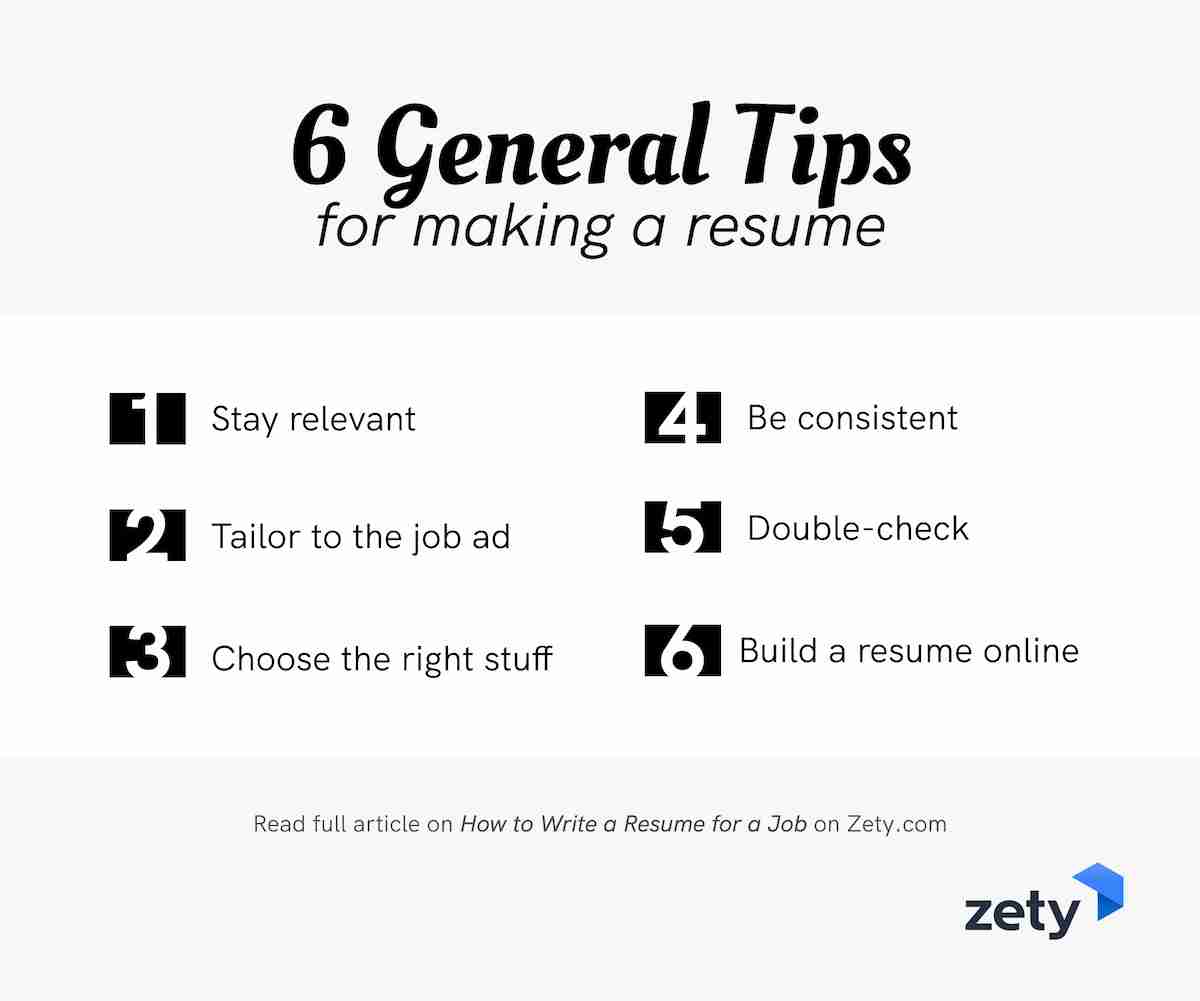
That was super-detailed, we know. So here's a few general resume tips for making a resume:
- Stay relevant—Every single item on your resume should prove you are the best possible candidate.
- Tailor—Make one resume specifically for one specific job and company to apply at. Name the company and pick skills which relate to the open position.
- Choose the right stuff—Use active voice, write a heading statement for your situation, and don't include unnecessary details.
- Be consistent—Follow the same formatting, styles, colors, and conventions throughout your resume.
- Double-check—Don't send your resume off before you are certain there are no typos and errors. Ask a friend for help or do go through a resume critique.
- Build a resume online—Use Zety's easy resume helper to write your cover letter and resume in no time. More than twenty resume examples and templates are there to help guide you. And, with the tips and advice it gives along the way, you know you'll have a great resume that gets the dream job! We think it's the best resume builder out there.
Have any questions on how to write a resume? Not sure how to make the perfect resume work experience section or how to build a resume list of skills or achievements? Get at us in the comments below and we'll answer your questions. Thanks for reading, and good luck with your résumé preparation!
How To Create Bio Data For Job
Source: https://zety.com/blog/how-to-make-a-resume
Posted by: solistheaks.blogspot.com

0 Response to "How To Create Bio Data For Job"
Post a Comment